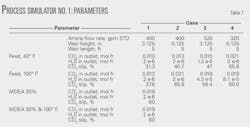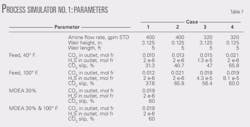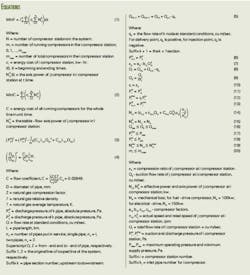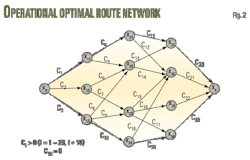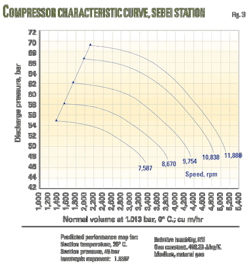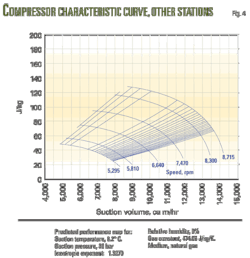ogj Focus: Model reduces operating costs of long-distance twinned pipeline
A new methodology maximizes the efficiency of a long-distance twinned natural gas pipeline system, adjusting for seasonal fluctuations in both demand and climate.
Se-Ning-Lan natural gas parallel-pipe system consists of the previous Se-Ning-Lan natural gas pipe and its loop line (Fig. 1). The loop parallels the previous line for most of its route, making one partial detour, and shares the first line's compressors. The loop line project runs 921.4 km eastward from east of Chai-Da-Mu basin in Qinghai province to the No. 35 valve room at Lanzhou, Gansu province, using 660-mm (26-in.) OD line pipe at a 6.3 MPa (914 psi) design pressure. The system has a maximum capacity of 19.05 million cu m/day (about 673 MMcfd), 9.72 million cu m/day of which is carried by the loop line.
Compressor model
The system operates with two parallel lines, allowing flexibility in shutting down sections of line between stations when needed but also raising the complexity of operating the pipeline as compared with a single-line system. Taking full advantage of the parallel system's flexibility, while at the same time managing its complexity, requires developing an appropriate operational strategy that combines the variance in gas demand and the system's operational thresholds.
Building the math model to optimize the looped-line system's compressor performance requires deciding objective function and decision-making variables. Minimal total energy cost is the model's goal. Choosing decision-making variables requires further analysis of the factors influencing total energy use. Those factors include:
• Parameters outside of operations departments, such as throughput, diameter, pipe length, elevation differences, ground temperature, and fuel and power costs.
• Parameters set by operations departments, such as station choke pressures, compressor configuration, and delivery requirements, all of which can be mandated by operators based on different scenarios.
• Parameters that vary with these other factors such as gas density, compression ratio, and compressor efficiency.
The main control parameter is the pressure of each station, which sets overall line pressure based on the configuration (running or shutdown) of each compressor.
Se-Ning-Lan natural gas parallel-pipe system design configured compressor stations to operate in parallel mode and share similar characteristic curves.
To simplify the model, this article uses the following hypotheses:
• Stable in-pipe gas flow.
• Zero local choke pressure loss at pipe joints and delivery points.
• At least one uninterrupted flow path from the beginning to the end of the line.
Objective function
The lowest possible energy cost includes both exhausted fuel and compressor power. If n compressor stations have m compressors, then Equation 1 (see accompanying box) shows the total energy cost's objective function.1-3
In a stable-flow hypothesis, Equation 1's objective is to minimize total energy cost for all running compressors over a given unit of time (Equation 2).
Constrained subject
Establishing transportation process parameters should include consideration of the finite nature of users' resources. Equations 3 and 4 can determine the limits governing optimal use of compressor stations on a complex looped-line system.
Fig. 1 shows the whole line can be divided into parallel pipe sections based on compressor stations, delivery points, valve rooms, and diameter-change points. Equations 3 and 4 show the pressure friction-loss function and flow-allocation functions for parallel pipe.4
For delivery point or injection point, based on mass balance, the standard flow rate of entry into the node should be equal to the outflow of the node, local frictional loss ignored (Equation 5).
Equation 6 represents this for a single delivery or injection station (not a compressor station).
A delivery or injection compressor station uses equations describing the relationship between the suction and discharge pressure of the station, which in turn depends on compressor configuration and the number of compressors running. The operational status of a compressor station is constrained to the minimum supply pressure, maximum operating pressure of the pipe, limits of inlet and outlet flow rate, maximum operational power of each compressor, and total number of compressors in the station.
Equation 7 provides the characteristics of j compressor at initial station, i.
Equation 8 provides total flow rate at i station.
Equation 9 provides j compressor's flow rate at i station.
The compression ratio of i station equals the compression ratio of any compressor in that station (Equation 10).
The suction pressure of i station equals the discharge pressure of the pipe section connected to that station (Equation 11).
The compression ratio of i station equals the ratio of the discharge to the suction pressure. Equation 12 shows i station's discharge pressure.
The front-end pressure of ki + 1 pipe section equals the discharge pressure of the station connected to the pipe section (Equation 13).
Equation 14 provides the effective power of j compressor at i station, with Equation 15 expressing its axis power.
Equations 16-19 express constraint conditions on flow rate, suction, discharge pressure, and input power for j compressor at i station.
The number of running compressors should be less than the number of compressors at i station (Equation 20).
The initial station's suction pressure and flow rate are equal to the source parameters.
Solution
The operational optimal model of a gas pipeline is a non-linear program in which all parameters are discrete variables except pressure and compression ratio.5 6
For a given flow rate to transport a certain volume of gas, determining the pressure of each compressor station is similar to resource allocation in math programming. The goal is to minimize the compressors' total energy cost.
The model can change to a route problem determining the shortest path instead of minimal cost. Fig. 2 shows a route network in which the operational optimal model has four compressor stations serving the entire line.
The algorithm of the model includes two steps, the status recursion and the function recursion. At the end of the function recursion, a retrospective process confirms optimal decision-making and compressor configuration strategy. Using a synchronal recursion allows alternative calculation of status and function recursions in a synchronal mode.
A matlab tool compiles the model's calculations.
Application
The calculation's results recommend a two-pronged strategy, one to ensure stable summer operations while maximizing throughput and the other to do the same for winter operations.
Data used for application of these results include:
• Suction pressure, initial station, 4.5 MPa (gauge pressure unless otherwise indicated).
• Minimum pressure, Lanzhou terminal station, 3.5MPa.
• Average pipe temperature, 30° C.
• Pipe length (Table 1).
• Characteristic compressor curves (Figs. 3-4).
• Maximum summer-winter throughputs (Tables 2-3).
Table 4 shows the optimal operation strategy for the parallel pipeline system.
References
1. Li, B., Zhu, H.F., and Li, J.X., Optimal design of natural gas pipeline," Oil and Gas Storage and Transportation (Chinese), Vol. 19, No. 8, 2000.
2. Pu, J.N., The analysis and calculation of operational optimization for pipeline," Oil and Gas Storage and Transportation (Chinese), Vol. 11, No. 1, 1992.
3. Li, C.J., Operational optimization of natural gas pipeline," Natural Gas Industry (Chinese), Vol. 25, No. 10, 2005.
4. Yao, G.Z., Design and Management of Natural Gas Pipeline," Petroleum University of China Press, Beijing, 1989.
5. Wang, J.Q., and Zhang, B.M., Dynamic programming to optimize compressor configuration," Electrical and Mechanical Engineering Journal (Chinese), Vol. 16, No. 4, 1996.
6. Wu, C.C., Dynamic programming and algorithm for optimal pressure allocation of a pipeline," Petroleum Journal (Chinese), Vol. 13, Supplement, 1992.
The authors
Wang Yonghong ([email protected]) is a PhD candidate at Beijing Key Laboratory of Urban Oil and Gas Distribution Technology, Department of Oil & Gas Storage and Transportation, China University of Petroleum. He earned his MS in oil and gas storage and transportation from China University of Petroleum-Beijing (2007).
Gong Jing ([email protected]) is a professor at China University of Petroleum. She also serves as deputy dean of petroleum engineering at the university, concentrating on transportation technology of long-distance pipelines and theory and technology of multiphase flow and oil-gas gathering. She earned her PhD in oil and gas storage and transportation from China University of Petroleum-Beijing (1995).
Li Xiaoping ([email protected]) is an associate professor at China University of Petroleum, concentrating on transportation technology of long-distance pipelines and theory and technology of multiphase flow and oil-gas gathering. He earned his PhD in oil and gas storage and transportation from China University of Petroleum-Beijing (2005).
Wu Haihao ([email protected]) is an instructor at China University of Petroleum, concentrating on transportation technology of long-distance pipelines and theory and technology of multiphase flow and oil-gas gathering. He earned his MS in oil and gas storage and transportation from China University of Petroleum-Beijing (2003).
Liu Zhenfang ([email protected]) is an engineer at PetroChina oil and gas pipeline control center, Beijing. He earned his BS in computer science and technology from Beijing Information Science and Technology University (2003).
More Oil & Gas Journal Current Issue Articles
More Oil & Gas Journal Archives Issue Articles
View Oil and Gas Articles on PennEnergy.com
